Chapter 16: The Expanding Universe
Chapter 1
How Science Works
- The Scientific Method
- Evidence
- Measurements
- Units and the Metric System
- Measurement Errors
- Estimation
- Dimensions
- Mass, Length, and Time
- Observations and Uncertainty
- Precision and Significant Figures
- Errors and Statistics
- Scientific Notation
- Ways of Representing Data
- Logic
- Mathematics
- Geometry
- Algebra
- Logarithms
- Testing a Hypothesis
- Case Study of Life on Mars
- Theories
- Systems of Knowledge
- The Culture of Science
- Computer Simulations
- Modern Scientific Research
- The Scope of Astronomy
- Astronomy as a Science
- A Scale Model of Space
- A Scale Model of Time
- Questions
Chapter 2
Early Astronomy
- The Night Sky
- Motions in the Sky
- Navigation
- Constellations and Seasons
- Cause of the Seasons
- The Magnitude System
- Angular Size and Linear Size
- Phases of the Moon
- Eclipses
- Auroras
- Dividing Time
- Solar and Lunar Calendars
- History of Astronomy
- Stonehenge
- Ancient Observatories
- Counting and Measurement
- Astrology
- Greek Astronomy
- Aristotle and Geocentric Cosmology
- Aristarchus and Heliocentric Cosmology
- The Dark Ages
- Arab Astronomy
- Indian Astronomy
- Chinese Astronomy
- Mayan Astronomy
- Questions
Chapter 3
The Copernican Revolution
- Ptolemy and the Geocentric Model
- The Renaissance
- Copernicus and the Heliocentric Model
- Tycho Brahe
- Johannes Kepler
- Elliptical Orbits
- Kepler's Laws
- Galileo Galilei
- The Trial of Galileo
- Isaac Newton
- Newton's Law of Gravity
- The Plurality of Worlds
- The Birth of Modern Science
- Layout of the Solar System
- Scale of the Solar System
- The Idea of Space Exploration
- Orbits
- History of Space Exploration
- Moon Landings
- International Space Station
- Manned versus Robotic Missions
- Commercial Space Flight
- Future of Space Exploration
- Living in Space
- Moon, Mars, and Beyond
- Societies in Space
- Questions
Chapter 4
Matter and Energy in the Universe
- Matter and Energy
- Rutherford and Atomic Structure
- Early Greek Physics
- Dalton and Atoms
- The Periodic Table
- Structure of the Atom
- Energy
- Heat and Temperature
- Potential and Kinetic Energy
- Conservation of Energy
- Velocity of Gas Particles
- States of Matter
- Thermodynamics
- Entropy
- Laws of Thermodynamics
- Heat Transfer
- Thermal Radiation
- Wien's Law
- Radiation from Planets and Stars
- Internal Heat in Planets and Stars
- Periodic Processes
- Random Processes
- Questions
Chapter 5
The Earth-Moon System
- Earth and Moon
- Early Estimates of Earth's Age
- How the Earth Cooled
- Ages Using Radioactivity
- Radioactive Half-Life
- Ages of the Earth and Moon
- Geological Activity
- Internal Structure of the Earth and Moon
- Basic Rock Types
- Layers of the Earth and Moon
- Origin of Water on Earth
- The Evolving Earth
- Plate Tectonics
- Volcanoes
- Geological Processes
- Impact Craters
- The Geological Timescale
- Mass Extinctions
- Evolution and the Cosmic Environment
- Earth's Atmosphere and Oceans
- Weather Circulation
- Environmental Change on Earth
- The Earth-Moon System
- Geological History of the Moon
- Tidal Forces
- Effects of Tidal Forces
- Historical Studies of the Moon
- Lunar Surface
- Ice on the Moon
- Origin of the Moon
- Humans on the Moon
- Questions
Chapter 6
The Terrestrial Planets
- Studying Other Planets
- The Planets
- The Terrestrial Planets
- Mercury
- Mercury's Orbit
- Mercury's Surface
- Venus
- Volcanism on Venus
- Venus and the Greenhouse Effect
- Tectonics on Venus
- Exploring Venus
- Mars in Myth and Legend
- Early Studies of Mars
- Mars Close-Up
- Modern Views of Mars
- Missions to Mars
- Geology of Mars
- Water on Mars
- Polar Caps of Mars
- Climate Change on Mars
- Terraforming Mars
- Life on Mars
- The Moons of Mars
- Martian Meteorites
- Comparative Planetology
- Incidence of Craters
- Counting Craters
- Counting Statistics
- Internal Heat and Geological Activity
- Magnetic Fields of the Terrestrial Planets
- Mountains and Rifts
- Radar Studies of Planetary Surfaces
- Laser Ranging and Altimetry
- Gravity and Atmospheres
- Normal Atmospheric Composition
- The Significance of Oxygen
- Questions
Chapter 7
The Giant Planets and Their Moons
- The Gas Giant Planets
- Atmospheres of the Gas Giant Planets
- Clouds and Weather on Gas Giant Planets
- Internal Structure of the Gas Giant Planets
- Thermal Radiation from Gas Giant Planets
- Life on Gas Giant Planets?
- Why Giant Planets are Giant
- Gas Laws
- Ring Systems of the Giant Planets
- Structure Within Ring Systems
- The Origin of Ring Particles
- The Roche Limit
- Resonance and Harmonics
- Tidal Forces in the Solar System
- Moons of Gas Giant Planets
- Geology of Large Moons
- The Voyager Missions
- Jupiter
- Jupiter's Galilean Moons
- Jupiter's Ganymede
- Jupiter's Europa
- Jupiter's Callisto
- Jupiter's Io
- Volcanoes on Io
- Saturn
- Cassini Mission to Saturn
- Saturn's Titan
- Saturn's Enceladus
- Discovery of Uranus and Neptune
- Uranus
- Uranus' Miranda
- Neptune
- Neptune's Triton
- Pluto
- The Discovery of Pluto
- Pluto as a Dwarf Planet
- Dwarf Planets
- Questions
Chapter 8
Interplanetary Bodies
- Interplanetary Bodies
- Comets
- Early Observations of Comets
- Structure of the Comet Nucleus
- Comet Chemistry
- Oort Cloud and Kuiper Belt
- Kuiper Belt
- Comet Orbits
- Life Story of Comets
- The Largest Kuiper Belt Objects
- Meteors and Meteor Showers
- Gravitational Perturbations
- Asteroids
- Surveys for Earth Crossing Asteroids
- Asteroid Shapes
- Composition of Asteroids
- Introduction to Meteorites
- Origin of Meteorites
- Types of Meteorites
- The Tunguska Event
- The Threat from Space
- Probability and Impacts
- Impact on Jupiter
- Interplanetary Opportunity
- Questions
Chapter 9
Planet Formation and Exoplanets
- Formation of the Solar System
- Early History of the Solar System
- Conservation of Angular Momentum
- Angular Momentum in a Collapsing Cloud
- Helmholtz Contraction
- Safronov and Planet Formation
- Collapse of the Solar Nebula
- Why the Solar System Collapsed
- From Planetesimals to Planets
- Accretion and Solar System Bodies
- Differentiation
- Planetary Magnetic Fields
- The Origin of Satellites
- Solar System Debris and Formation
- Gradual Evolution and a Few Catastrophies
- Chaos and Determinism
- Extrasolar Planets
- Discoveries of Exoplanets
- Doppler Detection of Exoplanets
- Transit Detection of Exoplanets
- The Kepler Mission
- Direct Detection of Exoplanets
- Properties of Exoplanets
- Implications of Exoplanet Surveys
- Future Detection of Exoplanets
- Questions
Chapter 10
Detecting Radiation from Space
- Observing the Universe
- Radiation and the Universe
- The Nature of Light
- The Electromagnetic Spectrum
- Properties of Waves
- Waves and Particles
- How Radiation Travels
- Properties of Electromagnetic Radiation
- The Doppler Effect
- Invisible Radiation
- Thermal Spectra
- The Quantum Theory
- The Uncertainty Principle
- Spectral Lines
- Emission Lines and Bands
- Absorption and Emission Spectra
- Kirchoff's Laws
- Astronomical Detection of Radiation
- The Telescope
- Optical Telescopes
- Optical Detectors
- Adaptive Optics
- Image Processing
- Digital Information
- Radio Telescopes
- Telescopes in Space
- Hubble Space Telescope
- Interferometry
- Collecting Area and Resolution
- Frontier Observatories
- Questions
Chapter 11
Our Sun: The Nearest Star
- The Sun
- The Nearest Star
- Properties of the Sun
- Kelvin and the Sun's Age
- The Sun's Composition
- Energy From Atomic Nuclei
- Mass-Energy Conversion
- Examples of Mass-Energy Conversion
- Energy From Nuclear Fission
- Energy From Nuclear Fusion
- Nuclear Reactions in the Sun
- The Sun's Interior
- Energy Flow in the Sun
- Collisions and Opacity
- Solar Neutrinos
- Solar Oscillations
- The Sun's Atmosphere
- Solar Chromosphere and Corona
- Sunspots
- The Solar Cycle
- The Solar Wind
- Effects of the Sun on the Earth
- Cosmic Energy Sources
- Questions
Chapter 12
Properties of Stars
- Stars
- Star Names
- Star Properties
- The Distance to Stars
- Apparent Brightness
- Absolute Brightness
- Measuring Star Distances
- Stellar Parallax
- Spectra of Stars
- Spectral Classification
- Temperature and Spectral Class
- Stellar Composition
- Stellar Motion
- Stellar Luminosity
- The Size of Stars
- Stefan-Boltzmann Law
- Stellar Mass
- Hydrostatic Equilibrium
- Stellar Classification
- The Hertzsprung-Russell Diagram
- Volume and Brightness Selected Samples
- Stars of Different Sizes
- Understanding the Main Sequence
- Stellar Structure
- Stellar Evolution
- Questions
Chapter 13
Star Birth and Death
- Star Birth and Death
- Understanding Star Birth and Death
- Cosmic Abundance of Elements
- Star Formation
- Molecular Clouds
- Young Stars
- T Tauri Stars
- Mass Limits for Stars
- Brown Dwarfs
- Young Star Clusters
- Cauldron of the Elements
- Main Sequence Stars
- Nuclear Reactions in Main Sequence Stars
- Main Sequence Lifetimes
- Evolved Stars
- Cycles of Star Life and Death
- The Creation of Heavy Elements
- Red Giants
- Horizontal Branch and Asymptotic Giant Branch Stars
- Variable Stars
- Magnetic Stars
- Stellar Mass Loss
- White Dwarfs
- Supernovae
- Seeing the Death of a Star
- Supernova 1987A
- Neutron Stars and Pulsars
- Special Theory of Relativity
- General Theory of Relativity
- Black Holes
- Properties of Black Holes
- Questions
Chapter 14
The Milky Way
- The Distribution of Stars in Space
- Stellar Companions
- Binary Star Systems
- Binary and Multiple Stars
- Mass Transfer in Binaries
- Binaries and Stellar Mass
- Nova and Supernova
- Exotic Binary Systems
- Gamma Ray Bursts
- How Multiple Stars Form
- Environments of Stars
- The Interstellar Medium
- Effects of Interstellar Material on Starlight
- Structure of the Interstellar Medium
- Dust Extinction and Reddening
- Groups of Stars
- Open Star Clusters
- Globular Star Clusters
- Distances to Groups of Stars
- Ages of Groups of Stars
- Layout of the Milky Way
- William Herschel
- Isotropy and Anisotropy
- Mapping the Milky Way
- Questions
Chapter 15
Galaxies
- The Milky Way Galaxy
- Mapping the Galaxy Disk
- Spiral Structure in Galaxies
- Mass of the Milky Way
- Dark Matter in the Milky Way
- Galaxy Mass
- The Galactic Center
- Black Hole in the Galactic Center
- Stellar Populations
- Formation of the Milky Way
- Galaxies
- The Shapley-Curtis Debate
- Edwin Hubble
- Distances to Galaxies
- Classifying Galaxies
- Spiral Galaxies
- Elliptical Galaxies
- Lenticular Galaxies
- Dwarf and Irregular Galaxies
- Overview of Galaxy Structures
- The Local Group
- Light Travel Time
- Galaxy Size and Luminosity
- Mass to Light Ratios
- Dark Matter in Galaxies
- Gravity of Many Bodies
- Galaxy Evolution
- Galaxy Interactions
- Galaxy Formation
- Questions
Chapter 17
Cosmology
- Cosmology
- Early Cosmologies
- Relativity and Cosmology
- The Big Bang Model
- The Cosmological Principle
- Universal Expansion
- Cosmic Nucleosynthesis
- Cosmic Microwave Background Radiation
- Discovery of the Microwave Background Radiation
- Measuring Space Curvature
- Cosmic Evolution
- Evolution of Structure
- Mean Cosmic Density
- Critical Density
- Dark Matter and Dark Energy
- Age of the Universe
- Precision Cosmology
- The Future of the Contents of the Universe
- Fate of the Universe
- Alternatives to the Big Bang Model
- Space-Time
- Particles and Radiation
- The Very Early Universe
- Mass and Energy in the Early Universe
- Matter and Antimatter
- The Forces of Nature
- Fine-Tuning in Cosmology
- The Anthropic Principle in Cosmology
- String Theory and Cosmology
- The Multiverse
- The Limits of Knowledge
- Questions
Chapter 18
Life On Earth
- Nature of Life
- Chemistry of Life
- Molecules of Life
- The Origin of Life on Earth
- Origin of Complex Molecules
- Miller-Urey Experiment
- Pre-RNA World
- RNA World
- From Molecules to Cells
- Metabolism
- Anaerobes
- Extremophiles
- Thermophiles
- Psychrophiles
- Xerophiles
- Halophiles
- Barophiles
- Acidophiles
- Alkaliphiles
- Radiation Resistant Biology
- Importance of Water for Life
- Hydrothermal Systems
- Silicon Versus Carbon
- DNA and Heredity
- Life as Digital Information
- Synthetic Biology
- Life in a Computer
- Natural Selection
- Tree Of Life
- Evolution and Intelligence
- Culture and Technology
- The Gaia Hypothesis
- Life and the Cosmic Environment
Chapter 19
Life in the Universe
- Life in the Universe
- Astrobiology
- Life Beyond Earth
- Sites for Life
- Complex Molecules in Space
- Life in the Solar System
- Lowell and Canals on Mars
- Implications of Life on Mars
- Extreme Environments in the Solar System
- Rare Earth Hypothesis
- Are We Alone?
- Unidentified Flying Objects or UFOs
- The Search for Extraterrestrial Intelligence
- The Drake Equation
- The History of SETI
- Recent SETI Projects
- Recognizing a Message
- The Best Way to Communicate
- The Fermi Question
- The Anthropic Principle
- Where Are They?
Overview of Large Scale Structure
Looking out across the sky, astronomers find structures at both Solar System scales and at scales far greater than any individual cluster of galaxies. These largest structures are actually referred to as the large-scale structure of the universe. On the scale of galaxies and larger, the structure is hierarchical — that is to say, galaxies are part of structures, which are part of larger structures, and so on. We actually find clusters of galaxy clusters, called galaxy superclusters. This progression doesn't go on forever, however, there is a scale at which on average the distribution of matter begins to be smooth (even though it's laid out in "particles" or units of galaxies). This scale is about 100 Mpc or 330 million light years.
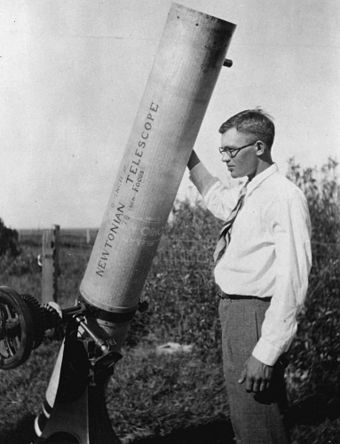
Gravity has a long reach and can cause galaxies to aggregate on an enormous scale. Astronomers naturally speculated that even larger structures than galaxy clusters might exist. In the 1940s, Clyde Tombaugh, the discoverer of Pluto, plotted the positions of galaxies in the sky and made the first map of a structure of galaxies that spanned much of the northern sky. He showed it to Edwin Hubble, who refused to believe the observation, no doubt because no one at that time expected to see such large structures. Part of this reluctance comes from the belief that if we look at the universe on a large scale everything is the same everywhere. This is the assumption of isotropy and homogeneity. Isotropy is the idea that the universe looks roughly the same in any direction, and homogeneity is the idea that the universe is roughly the same at any location. You can see that these are quite different assumptions. It's easy to point a telescope in a different direction, but it's impossible to relocate ourselves to a distant location in the universe! What wasn't understood at the time of Tombaugh and Hubble was just how big a scale we have to look at in the universe to verify this assumption.

Twenty years later, French astronomer Gerard de Vaucouleurs showed that the Milky Way is in fact part of an enormous flattened structure called the Local Supercluster. A projection of the brightest galaxies in the northern and southern sky reveals a high concentration of galaxies running in a strip across the sky, nearly at right angles to the Milky Way. This flattened structure of galaxies is analogous to the flattened disk of stars in the Milky Way. Other astronomers were skeptical of de Vaucouleurs' work and he didn't have redshifts to verify that the structure existed in three dimensions.
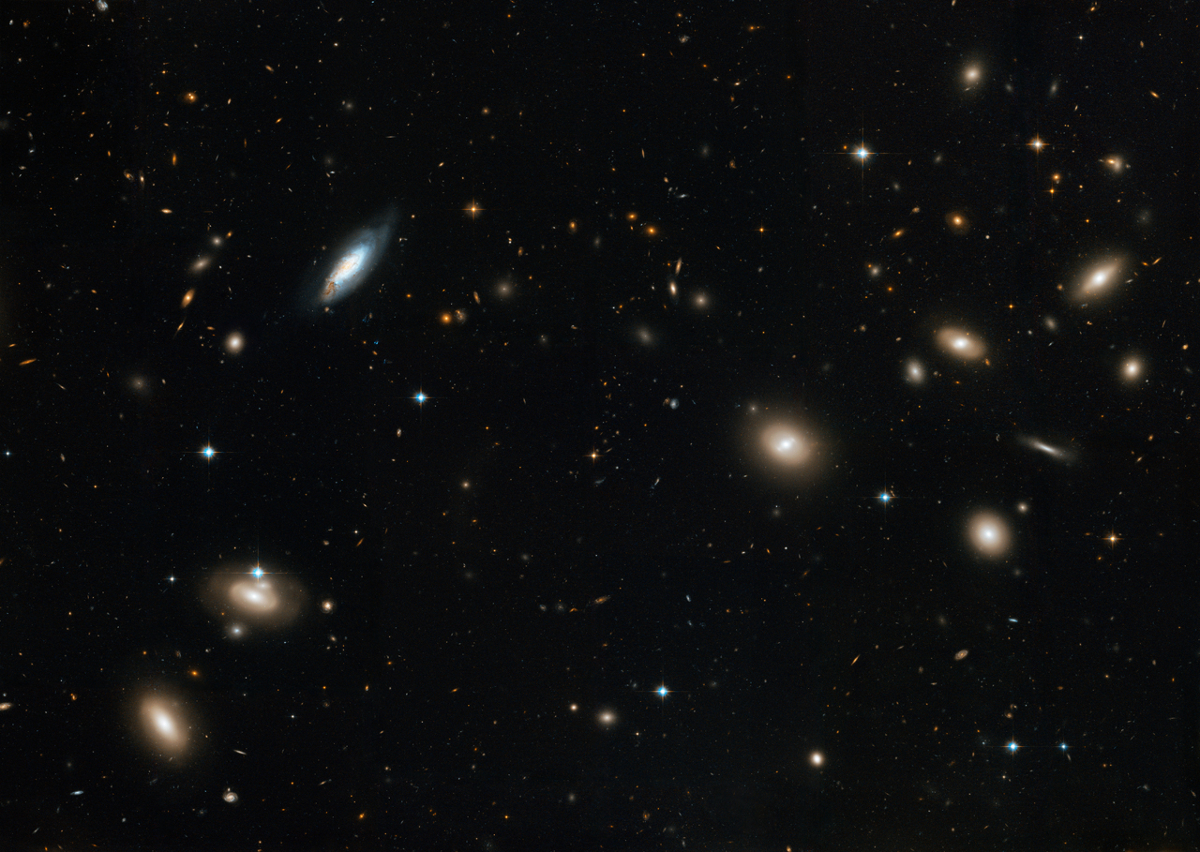
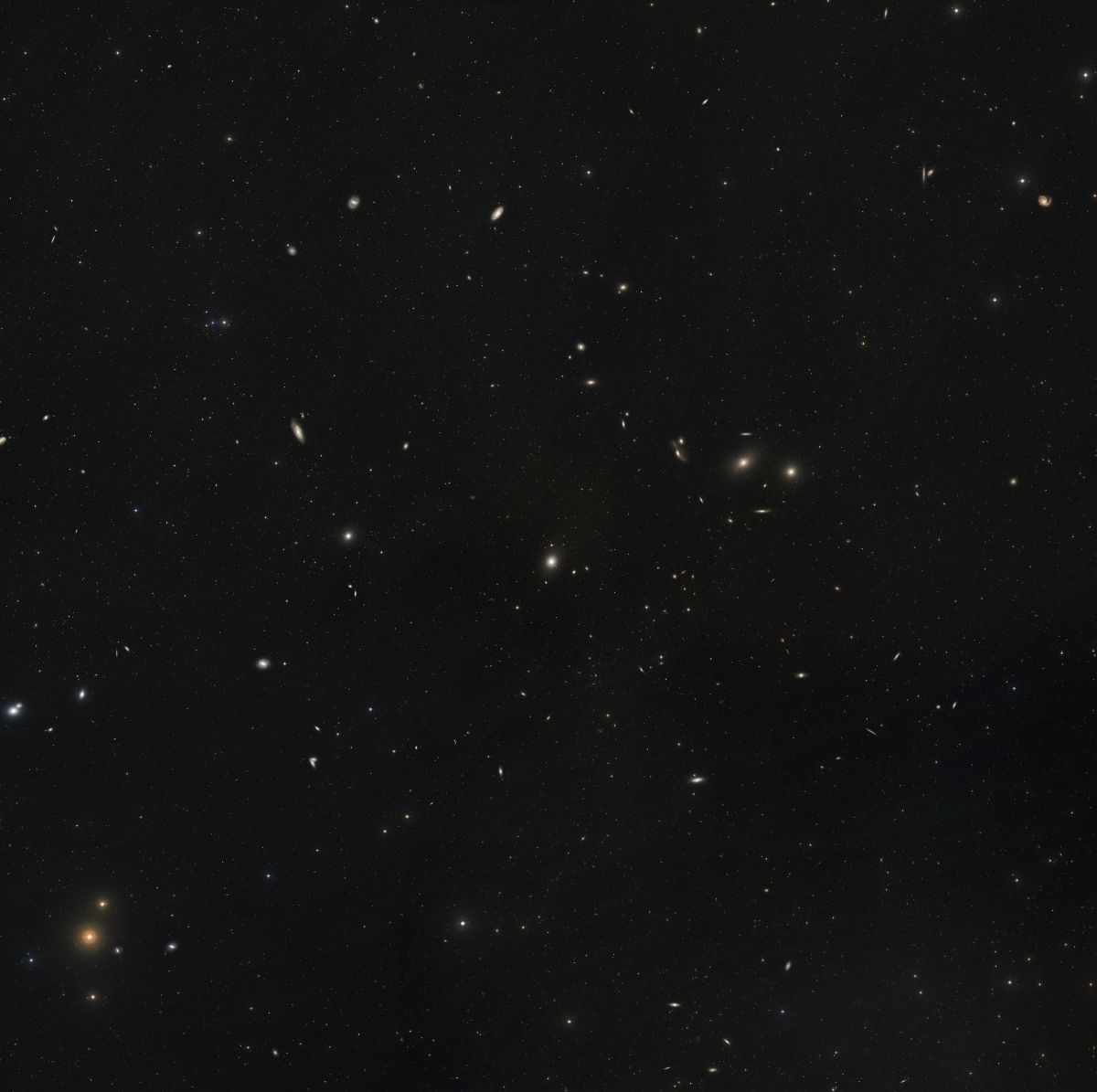

The Local Supercluster contains the Local Group, the Virgo and Coma clusters, and about 100 other clusters. It measures about 20 Mpc across by 2 Mpc thick and contains a total of 1016 solar masses. In other words, it would take light 65 million years to cross the Local Supercluster and this supercluster contains ten thousand trillion stars! The center of the Local Supercluster is near the Virgo cluster; the Milky Way is near the outskirts. The gravity of the Virgo cluster is so strong that we — the Milky Way and the entire Local Group — are being pulled into it at a speed of 250 km/s. You should not lose sleep over this, however, it will take many billions of years to get there.
Superclusters range in size from 50 to 100 Mpc across — this is a physical structure more than 300 million light-years across. By comparison, galaxy clusters are usually in the size range of 1 to 5 Mpc. On the largest scales, astronomers see knots or concentrations of galaxies, linear or filamentary features called walls, and regions where the galaxy density appears to be very low. Much modern research is devoted to understanding this complex web of large-scale structure. The mathematics of large-scale structure is reasonably well described by a fractal, where there is more and more structure on smaller and smaller scales.
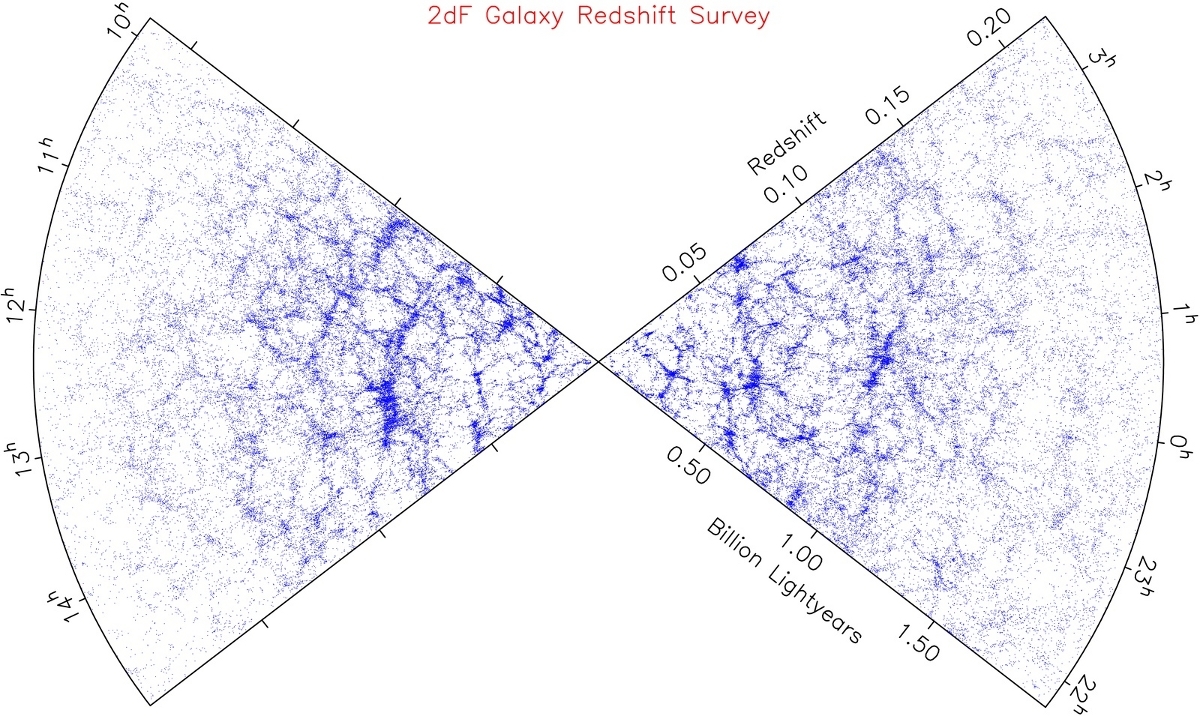
Sky maps of galaxies are not ideal for studying large-scale structures because they only represent two dimensions. Nearby and distant galaxies are very far apart yet they can appear close together in projection. The most detailed information on the large-scale structure thus has come from painstaking redshift surveys of galaxies in narrow "slices" of the universe. Rather than try the almost impossible task of measuring distances for thousands of galaxies, astronomers use recession velocity (or equivalently, redshift) as a distance indicator. Position on the sky plus redshift allows galaxies to be placed in three-dimensional space. The first of these surveys was carried out by Margaret Geller, John Huchra, and their collaborators at the Harvard-Smithsonian Center for Astrophysics. A series of separated slices can be used to reconstruct the distribution of galaxies over a large volume. Technology is advancing this science very quickly. By the 1990s, redshift surveys had measured over 100,000 galaxies and telescopes like the Sloan Digital Sky Survey telescope at Apache Point have increased this number to over a million. Astronomers are mapping out larger and larger regions of the universe, heirs to the pioneering cartographers who mapped our planet hundreds of years ago.
While redshift helps us understand the distances to clusters, this method of mapping the universe is not without flaws. Although the Coma cluster is spherical in shape, it appears elongated in redshift. This elongation occurs because the large mass of a cluster gives galaxies high orbital velocities within the clusters. The range in velocity, as some galaxies race towards us along their orbit and others race away along their orbit, spreads the redshift distribution of galaxies towards and away from the observer — astronomers call this the "finger of god" effect. In other words, redshift is a poor distance indicator of individual galaxies in a cluster. That said, the diversity of velocities in a single cluster can be averaged out giving us the true position of the cluster itself, even if we don't know the exact distance to individual galaxies.
A striking feature in surveys of galaxies and clusters over large volumes is the presence of voids in the galaxy distribution. The voids are nearly circular in cross-section and are nearly empty of bright galaxies. The Local Supercluster has been mapped out in three dimensions by Brent Tully. Most of the volume is completely empty of luminous matter. As many as 98% of the galaxies occupy only 5% of the volume. Some voids are over 150 Mpc across, or nearly half a billion light years, which is a whole lot of nothing!
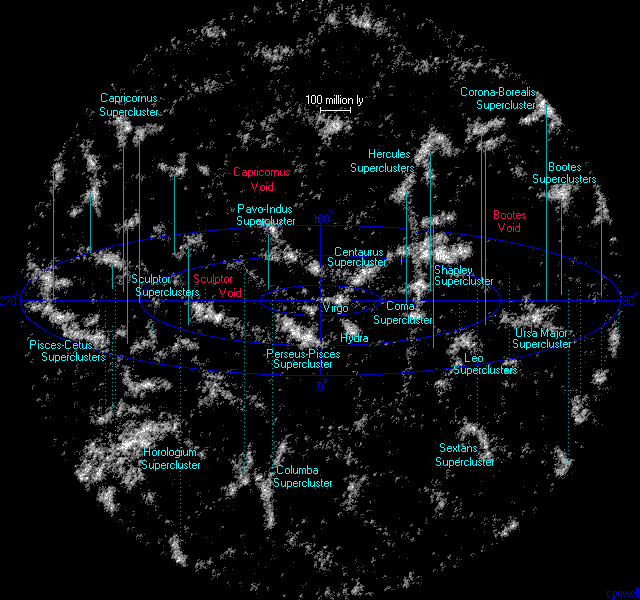
The mixture of superclusters, voids, and walls in the architecture of the universe has been steadily sculpted by gravity over billions of years. Astronomers have used colorful language to describe the structures they see. Historically, it was thought that the rich clusters were set in a uniform sea of galaxies, like meatballs. The discovery of strings and filaments of galaxies added a component of spaghetti. The first slices of the universe showed that the galaxies form large connecting structures around empty voids 20 to 100 Mpc across, like Swiss cheese. The most recent research indicates a single analogy that cleans up these various terms. The general emptiness of space — where galaxies are distributed in sheets and filaments and clusters are found at the junctions of the sheets — is like a network of soap bubbles. Astronomers have also used mathematics to describe large-scale structure. What is the typical shape, or topology, of the way galaxies cluster in space? A point has no dimensions, and in three-dimensional space, this would correspond to galaxies that were scattered with no clustering at all. A line has one dimension, so this would be the appropriate description of galaxies in stringy structures. A plane has two dimensions, so this would describe galaxies that are all contained in sheet-like structures. Recent analysis indicates that the large-scale structure has a dimension of about 1.7, which is partway between 1 and 2. In geometry terms, a dimension of 1.7 corresponds to structures that are somewhat string-like and somewhat sheet-like.
This description actually only works for the modern universe though. The universe started out as a nearly homogeneous gas. It's taken the full 13.8 billion years of cosmic evolution to get the structure we have today. As we look further back in the past, the number of superclusters diminishes, the voids shrink, and we see the universe going back to its more smooth original state. As the universe continues to evolve into the future, the structures we see will continue to contract; to gravitationally compress. More galaxies will merge, and more clusters will fall into superclusters. The structure we see is specific to the moment.
Even with all this structure, however, we still see the universe as isotropic and homogeneous at the largest scales. On scales of 10 or 30 Mpc, the observed variation in the number of galaxies exceeds the random variation expected from counting statistics (√N) — an indication of gravitational clustering. However, by a scale of 100 Mpc, the number of galaxies shows only a small fractional variation. By a scale of 300 Mpc, the universe is essentially smooth.
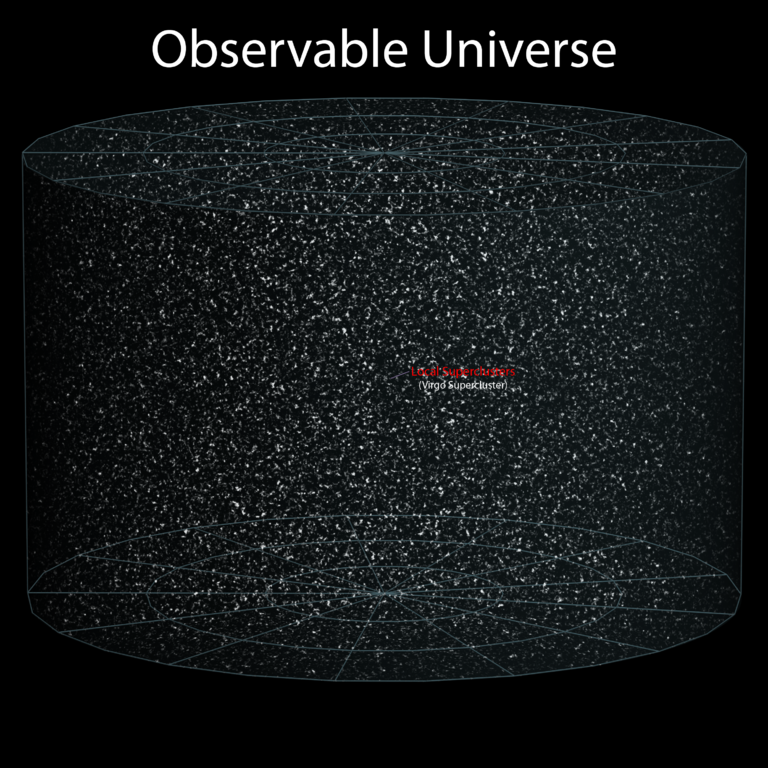
The study of large-scale structure reveals two important aspects of the universe on the largest scales we can measure. First, it is isotropic. We see a similar Hubble relation in every direction we look. We also see similar types of structures — clusters, superclusters, and voids — in every direction we look. Second, it is homogeneous. Imagine that you are looking down on a beach from a mile high. The grains of sand and pebbles would not be visible and the beach would appear smooth and featureless. Similarly, a mountain range would appear smooth as viewed from the Moon. Gravity has obviously formed lumps that range in size from planets and stars to clusters and superclusters of galaxies. But the universe is smooth on scales larger than about a billion light years, reflecting the smoothness of the original hot and dense state.

